Golden horses are a sight to behold.
Their eye-catching coats seem to glow like a warm, golden sunset. But did you know that “golden” isn’t an official horse color?
In reality, it’s a term that covers a range of shades including buckskin, palomino, and more.
Why Do They Look the Way They Do?
So what makes these horses so special?
It’s not just their golden looks. They each have unique genes that give them their signature colors.
Certain genes determine a horse’s basic coat color, while others dilute these colors to create the golden effect.
It’s a mix of science and natures art that has led to some of the most beautiful horses you’ll ever see.
7 Golden Horse Coat Colors
So you’re captivated by the allure of golden horses, but what actually counts as a golden coat?
While not an official term in horse registries, the descriptor “golden” encompasses a range of shades that offer their own unique beauty and characteristics.
Let’s break down some of the most eye-catching golden horse coat colors.
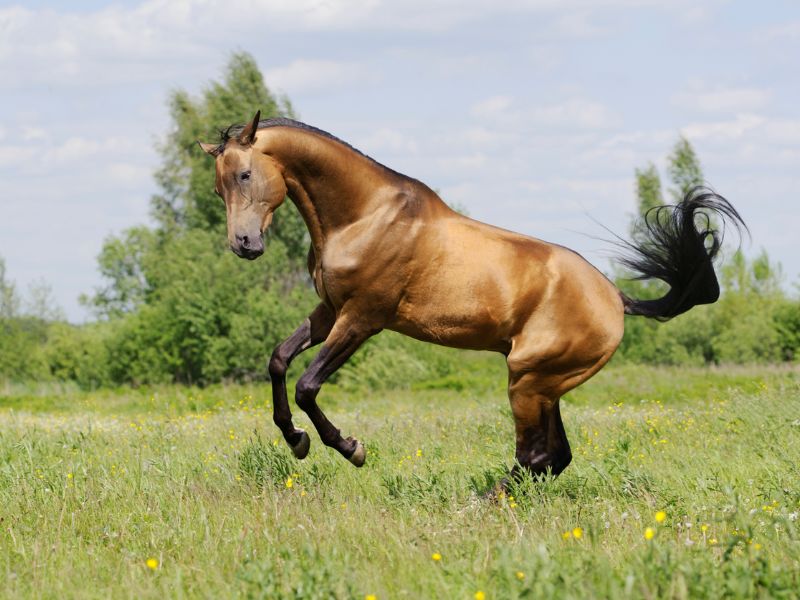
1. Buckskin: A Closer Look at This Golden Marvel
Buckskin horses are a sight to behold, thanks to their unique shade that falls between tan and light bronze.
Their coats have a way of capturing and reflecting the sun, making them look as if they’re glowing.
What Makes Buckskins Unique?
So what sets buckskins apart from other golden-coated horses?
They have what’s known as a “dilution gene,” called the cream gene which lightens the base coat color, bay while keeping the golden undertones.
This results in the iconic buckskin color we all know and love.
Not Just a Palomino or Dun
You might think buckskins are just another type of palomino or dun horse, but that’s not the case.
While they may share some color traits, their genetics are different. What really sets buckskins apart are their black points—those fully black manes, tails, and lower legs—that create a striking contrast against their golden bodies.
Where Can You Find Them?
Buckskin coats aren’t limited to any particular breed.
They can be found in Quarter Horses, Appaloosas, Paint Horses, Andalusians, Friesians, and many more. This broad range makes them even more appealing to horse enthusiasts.
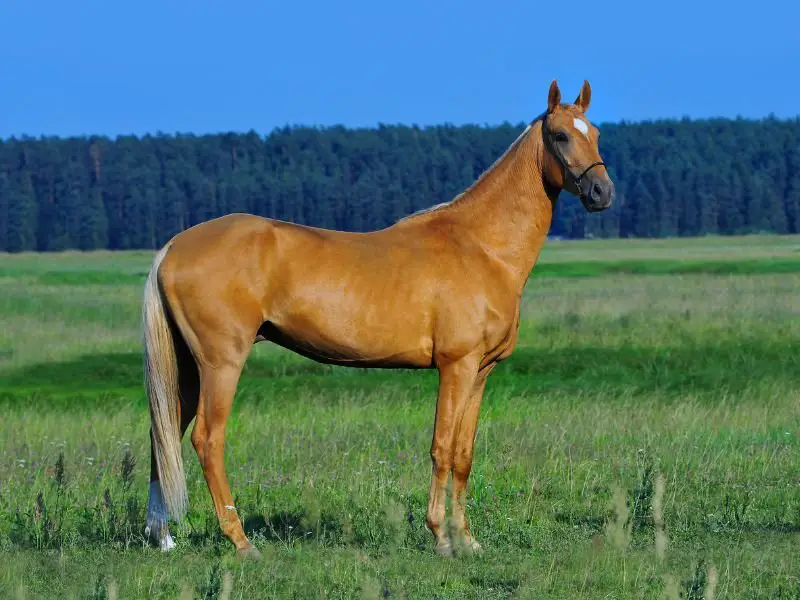
2. Palomino: The Gold Standard in Horse Colors
Palomino is not a breed as some people sometimes believe but rather a captivating color that has enthralled horse lovers for years.
These horses display a golden coat that can vary from creamy yellow to a more vibrant gold.
Where Did Palomino Come From?
While not a breed, the palomino color has a rich history.
It gained prominence during the era of Spanish conquistadors, who highly valued these golden horses for their majestic looks and calm nature.
The Genetics Behind the Color
The dazzling palomino coat color comes from one cream gene and one chestnut gene. This gene combination dilutes the chestnut color, resulting in the wide range of golden shades seen in palominos.
Where Can You Find Palomino Horses?
This golden color can be found in various breeds including Quarter Horses, American Saddlebreds, and Morgans. That means you can enjoy this stunning color in a variety of horse types.
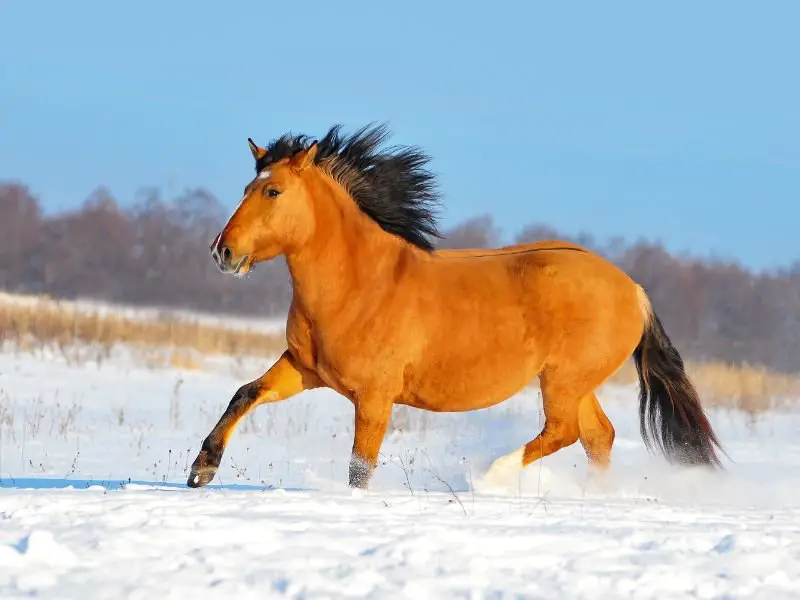
3. Dun: A Unique Golden Beauty With Distinct Markings
When it comes to golden horses, dun-colored ones add an extra layer of intrigue.
The term “bay dun” refers to a particular coat color that can range from a light tan to a deep gold. Dun is not just a color, but also a pattern, which makes these horses really stand out.
What Causes the Dun Color?
The dun color is a result of a special “dun gene” that dilutes the horse’s bay base coat. This gene leads to a variety of golden shades and specific markings that are unique to dun-colored horses.
Notable Features: Dorsal Stripe and Zebra Stripes
One easily recognizable feature is the dorsal stripe. This dark line runs down the horse’s back and is often joined by horizontal stripes on the legs, commonly called “zebra stripes.” These markings make the dun horse easy to identify among other golden-colored breeds.
Breeds with Dun Coloring
The dun color isn’t limited to a specific breed. You can find it in American Quarter Horses, Icelandic Horses, Fjords and Mustangs. However, not all horses in these breeds will show the dun coloration.
Among the different dun colorations, the bay dun horses have a yellow-gold color.
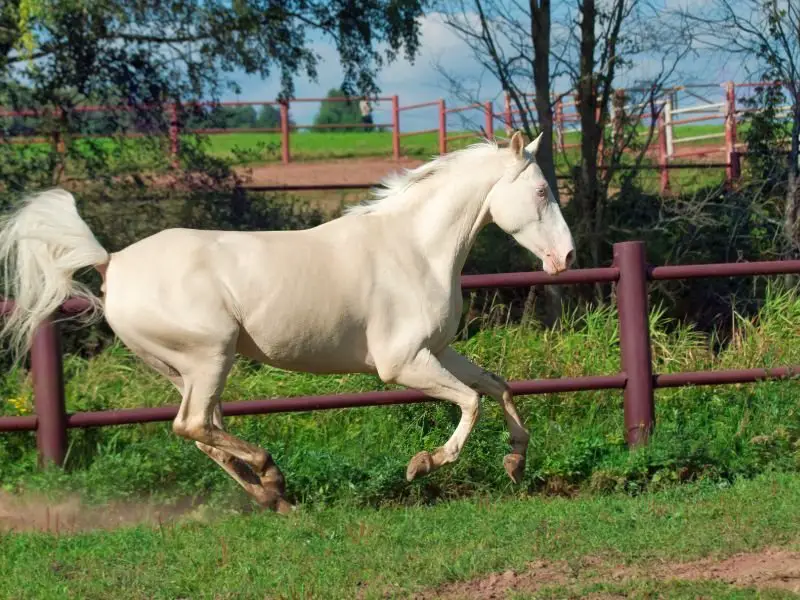
4. Cremello: The Creamy Gold Star of the Horse World
Cremello horses are undeniably eye-catching with their pale golden coats. If you’re looking for a horse that looks like it’s glowing, a cremello might be your answer.
How Do Horses Get the Cremello Color?
The cremello color comes from two cream genes that lightens the horse’s chestnut base coat. This gene can appear in multiple horse breeds and gives us the light creamy color of cremello horses.
Coat Color and Features
Their coats can be described as a soft, creamy white or a pale gold that seems to shimmer in the sun. Alongside their remarkable coat, cremellos also have unique pink skin and blue eyes that make them even more distinctive.
Double Dilutes: A Special Category
Cremellos are what’s known as “double dilutes,” meaning they get two cream genes from their parents.
This gives them a much lighter coat than other dilute horses like palominos or buckskins.
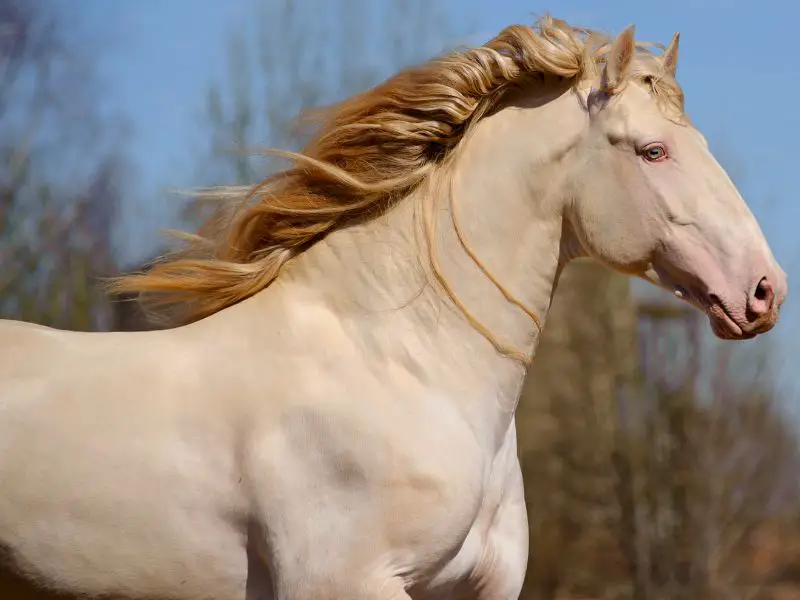
5. Perlino: A Glimpse of Golden Elegance
The perlino horse has a coat that truly captures attention with its creamy white color tinged with gold. Here’s what makes these horses so special.
The Genetic Blueprint for Perlino Color
The creamy color of a perlino horse is a result of two copies of the cream gene. This gene lightens the bay base coat, giving it that unique golden glow.
Coat and Appearance
The coat of a perlino horse isn’t just unique; it’s mesmerizing.
It shimmers and gives the horse an almost magical presence. But it’s not just the coat that makes perlinos stand out.
They often have light blue or hazel eyes and pink skin, adding to their already captivating look which is hard to ignore. Their flowing manes and tails catch the sunlight in such a way that you can’t help but admire them.
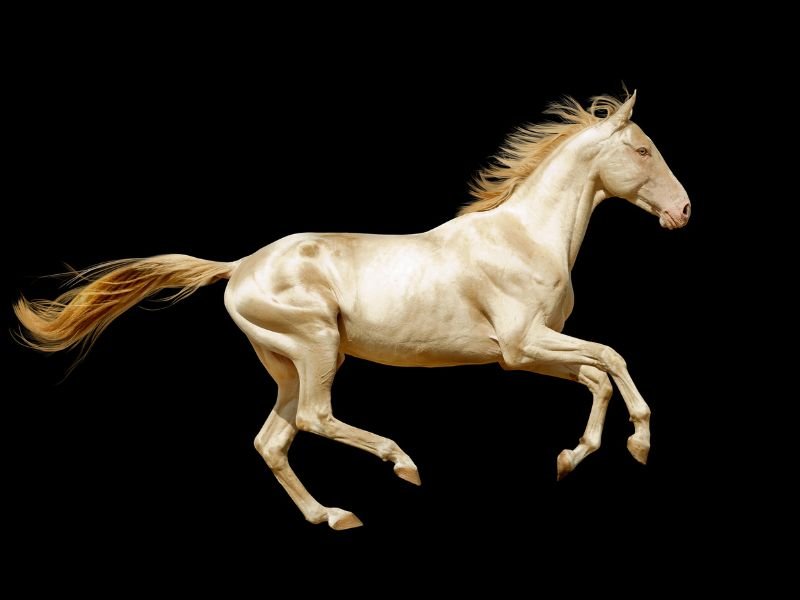
6. Champagne: The Gold Standard in Horse Coats
When you think of golden horses, the champagne coat color should definitely be on your list. Here’s what makes these horses so memorable.
What Causes the Champagne Color?
The champagne color is the result of a champagne dilution gene acting on a bay or chestnut base coat. This combination creates a unique color spectrum that can range from a pale gold to rich amber.
A Color Like No Other
Champagne horses might look similar to palominos or cremellos, but they’re unique. The distinguishing feature of champagne horses is their metallic sheen. It’s like their coat has a special sparkle that sets them apart from other horses.
Where to Find Champagne Horses
Champagne horses aren’t limited to one breed. You can find them in various horse communities, like the Akhal Teke, American Quarter Horse and the Missouri Fox Trotter. These breeds often showcase the stunning champagne coat, further emphasizing their strong build or elegant moves.
The Spellbinding Effect
It’s hard to look away from a champagne horse. Their coat seems to dance and glimmer in the sunlight, capturing the attention and hearts of anyone who sees them.
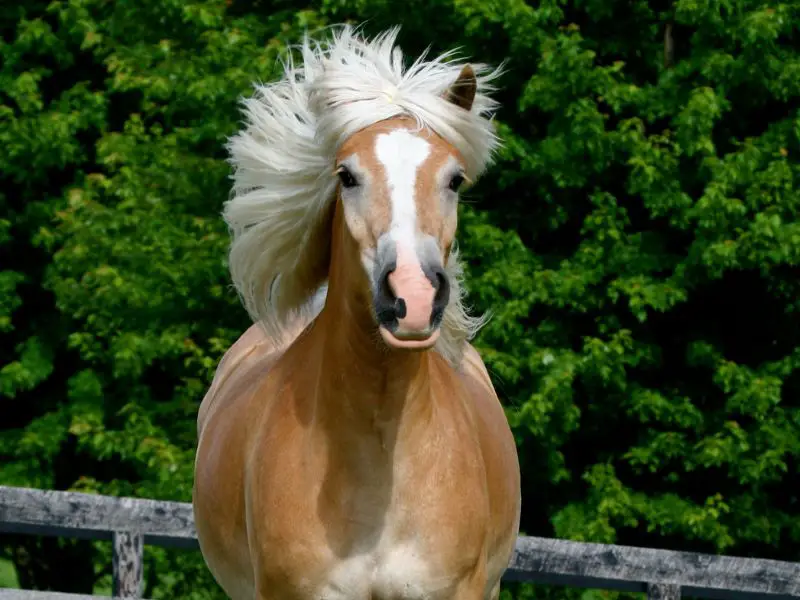
7. Flaxen Chestnuts That Resemble Palominos
Golden horses are often thought to be palominos, but another striking horse color that can be easily mistaken for palomino is the flaxen chestnut.
What Makes Them Different Yet Similar?
Flaxen chestnuts have a reddish-brown base coat with a lighter, often blonde, mane and tail. At first glance, they might look like palominos, which are golden horses with a cream or white mane and tail.
But flaxen chestnuts are different, even if their light manes and tails can make them look somewhat golden.
The Genetic Factor
While palominos result from a single copy of the cream dilution gene acting on a chestnut base coat, flaxen chestnuts get their look from a different gene that affects only the mane and tail.
So, if you see a horse that looks golden but doesn’t quite fit the palomino mold, it could be a flaxen chestnut.
The Shimmering Gold Akhal-Teke
The Akhal-Teke is a standout breed, and its sparkling gold coat is just one of the many features that make this horse so special.
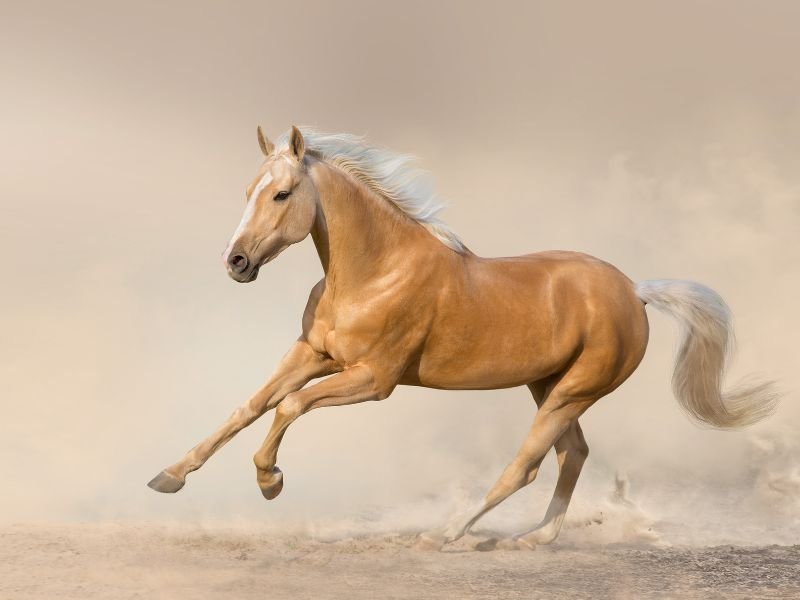
Origins and Uniqueness
This breed comes from Turkmenistan and has long been celebrated for its unique and shiny coats. The coat color can range from black, to bay, to chestnut to light champagne to deep metallic gold. Because of their sheen and overall appearance, they’re sometimes referred to as “golden horses.”
Mane, Tail, and Coat Function
Akhal-Tekes don’t just have a beautiful mane and tail; they also serve a purpose. The reflective properties of their coats help keep them cool in the harsh desert environments they originally come from.
Athletic Abilities
But Akhal-Tekes are not just for show. They’re athletes, excelling in disciplines like dressage, jumping, and endurance riding.
Their body structure contributes to their agility and speed, making them competitive in various equestrian events.
Temperament and Loyalty
Besides their looks and athleticism, Akhal-Tekes are also known for their high energy, intelligence and loyalty.
They form close bonds with their riders and are known for their desire to please, making them excellent companions whether you’re in the show ring or on a long trail ride.
10 Other Breeds With Golden Horses
The world of horses is as diverse as it is beautiful, especially when it comes to golden-coated breeds.
Aside from the spectacular Akhal-Teke, let’s take a look at some other breeds that wear the gold well and add their unique traits to the equestrian world.
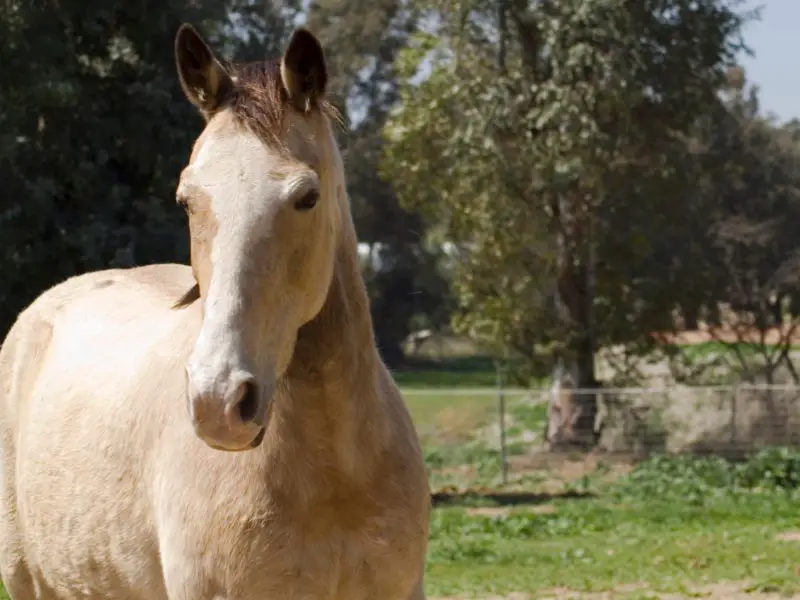
1. Tennessee Walking Horse: A Golden Exception
The Tennessee Walking Horse is admired for its unique walk and friendly nature, but some individuals stand out even more with their golden coats. Here’s why these golden Tennessee Walking Horses are so captivating.
Rarity and Appeal of the Golden Coat
While golden coats are not the most common in this breed, they’re highly prized by horse lovers. These horses carry a beauty that distinguishes them from other Tennessee Walking Horses.
Variations in Color
The shade of gold in these horses can vary. Some might have a deep, rich gold color, while others could be a lighter, pale amber. Factors like genetics and environment play a role in this color diversity, making each horse uniquely beautiful.
Famous Golden Tennessee Walker
Take “Golden Boy,” for example, a well-known stallion with a radiant golden coat. When this horse moves, he not only shows off the gracefulness typical of his breed but also his own rare and striking color.
Temperament and Activities
Beyond their stunning looks, golden Tennessee Walking Horses are often calm and easy-going, making them great for various equestrian activities like trail riding and pleasure driving. Their friendly demeanor makes them a hit among riders of all experience levels.
Why They Capture Hearts
Whether you see one at a horse show or out on a nature trail, the rare golden Tennessee Walking Horse is sure to captivate. These horses capture the essence of why the breed is loved by so many.
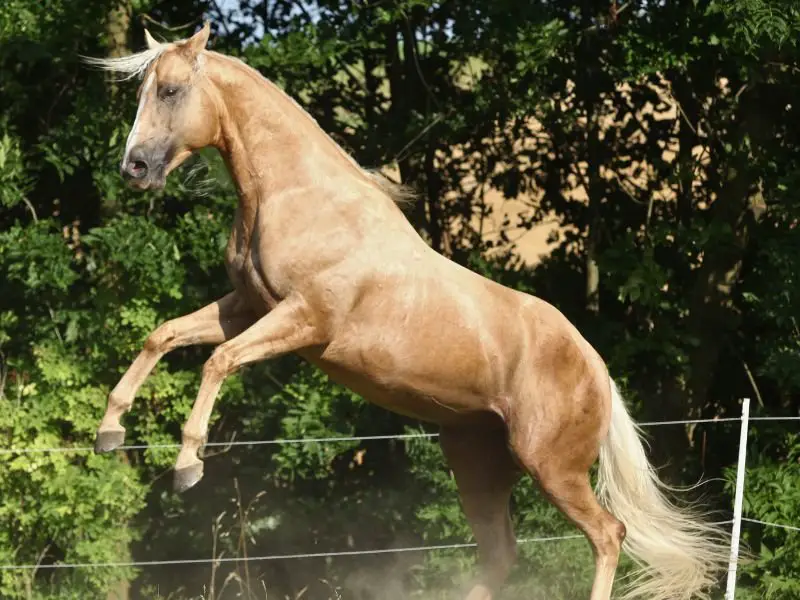
2. American Quarter Horse: The Gold Standard in Versatility and Beauty
The American Quarter Horse is not just one of America’s favorite breeds; it also comes in some truly amazing golden shades. Here’s why these horses are the whole package.
Golden Shades that Make a Statement
You’ll find American Quarter Horses in various shades of gold, from warm honey tones to vibrant metallic gold. Buckskin is a popular coat color that combines a golden body with darker points on the mane, tail, and lower legs. The contrast gives these horses a refined look that stands out.
Athleticism and Beauty Combined
Buckskin American Quarter Horses aren’t just for show; they’re also incredibly athletic. Whether they’re engaged in cutting, reining, or barrel racing, they’re a force to be reckoned with.
Palomino American Quarter Horses have golden coats that seem to glow. Whether they’re at horse shows or out on a trail, they’re bound to catch your eye. They feature creamy-golden bodies with white or ivory manes and tails, making them simply unforgettable.
Dun American Quarter Horses showcase a unique combination of gold tones, accented by primitive markings known as the “dun factor.” These markings include stripes down their backs and on their legs, adding complexity to their golden coats.
Among these golden shades, we also find the champagne color, which adds a magical shimmer to their coats. These American Quarter Horses shine with a unique metallic sheen that catches the light in extraordinary ways.
More than Just a Pretty Face
Golden American Quarter Horses offer more than just good looks. They are versatile, athletic, and well-suited for various horse sports, making them a beloved choice for many equestrians. When you see one, you’re not just seeing a pretty horse; you’re witnessing a blend of versatility and sheer beauty.
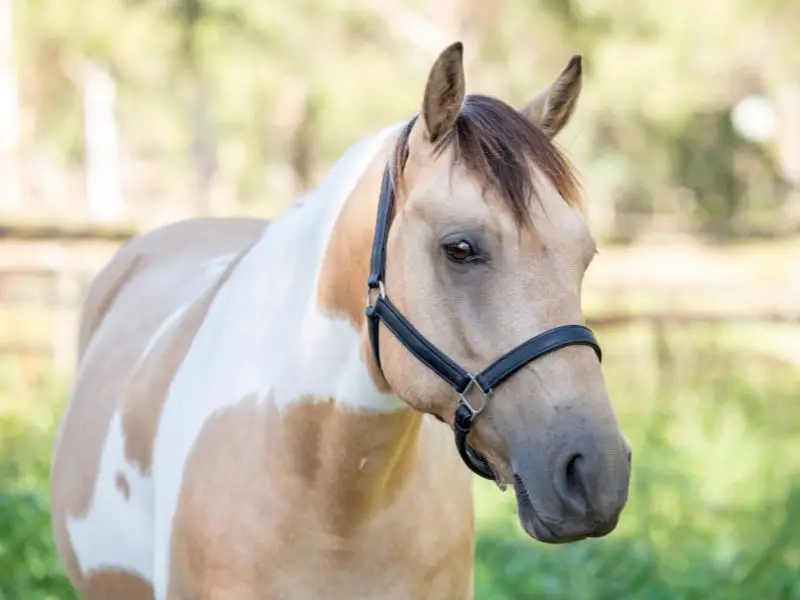
3. American Paint Horse: Golden Hues and Unique Patterns
The American Paint Horse is well-known for its unique coat patterns and striking golden colors. Let’s take a closer look at what sets this breed apart.
Recognized Coat Patterns
The American Paint Horse Association acknowledges several coat patterns including tovero, overo, and tobiano. Each of these can feature gold or chestnut hues alongside other colors. One of the crowd-favorites is the overo pattern, where large white patches are scattered over a golden or chestnut base coat.
More Than Just a Golden Coat
Sometimes you’ll even see golden spots within these white patches, adding an extra layer of uniqueness to their appearance. Another popular pattern is the tobiano, which shows off a bold contrast of a white-colored head and dark legs against a primarily golden or chestnut body.
Versatility and Temperament
Beyond their fantastic coats, American Paint Horses are versatile animals. They excel in a variety of disciplines such as western pleasure and competitive trail riding. They’re calm and suited for riders of all experience levels, making them a reliable option for anyone interested in riding.
A Horse That Turns Heads
Owning an American Paint Horse with a golden coat is like owning a piece of treasure. Whether you’re on a trail ride or in a competition, these horses are guaranteed to grab attention. Their blend of beautiful patterns and golden hues makes them a favorite among horse lovers globally.
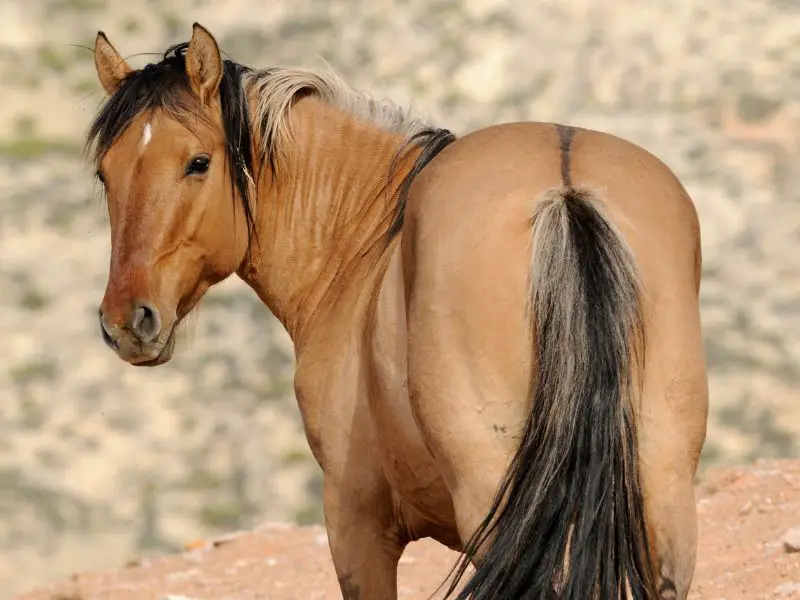
4. Mustang: The Golden Marvels of the American West
Mustangs are often seen as the living symbols of American freedom. But did you know that some of them come with radiant golden coats? Let’s explore the allure of these unique mustangs.
Golden mustangs often roam in areas with varied terrains, from open grasslands to deserts. The landscapes serve as beautiful backdrops, making these horses look even more spectacular.
Not Just Eye-Candy
Golden mustangs may be rare, but they are just as resilient as their more commonly colored counterparts. They’ve adapted to tough environments and can find food and water in places you’d least expect.
Strength in Diversity
The rare gold-coated mustangs serve as a testament to the breed’s diversity. And it’s not just Sunflower who can flaunt this color. Other mustangs also have golden coats, adding to the wonderful range of shades in this breed.
The Unique Allure of Golden Mustangs
Golden mustangs have a special place in the equine world, captivating anyone lucky enough to spot them. Their golden coats combined with their strong, free spirit make them a unique spectacle in the landscapes of the American West.
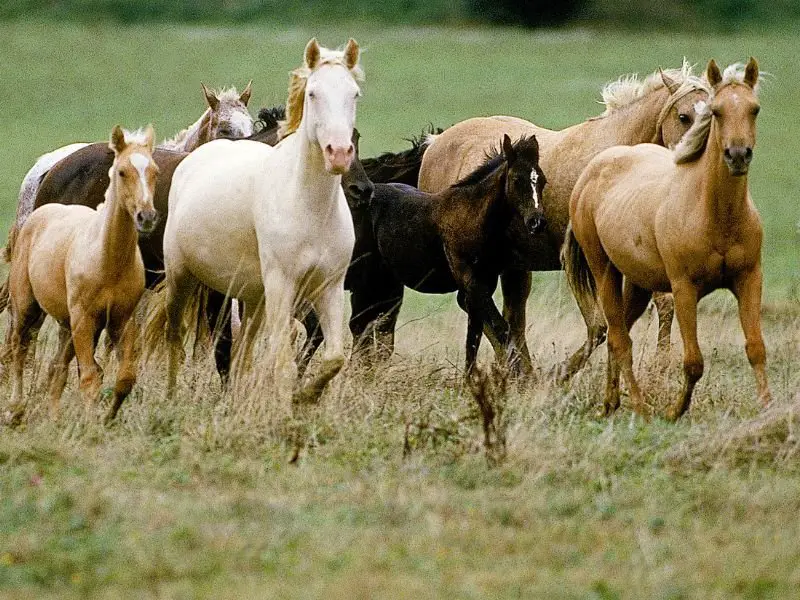
5. American Saddlebred: The Gold Standard in Showmanship
American Saddlebred horses are known for their dazzling golden coats and standout presence in the show ring. Let’s explore what sets these horses apart from other golden breeds.
A Visual Treat
One look at the American Saddlebred, and it’s clear why they steal the show. Their golden coats are not just shiny but also remarkably elegant. A flowing mane adds even more charm to this eye-catching breed.
Dress to Impress
American Saddlebreds aren’t just beautiful; they also dress the part. In the show ring, they often sport elaborate saddles and bridles that highlight their natural beauty. This makes them not just a sight to behold but also a testament to fine equestrian style.
Versatility in the Ring
Looks aren’t everything, and American Saddlebreds prove it. They’re skilled in a variety of disciplines like saddle seat riding, driving, and even jumping. Their strong muscles and sturdy build make them fit for a range of activities, from long-distance riding to executing intricate dressage moves.
A Great Personality
Besides their looks and abilities, American Saddlebreds have great temperaments. They’re smart, eager to please, and easy to work with, making them ideal for all kinds of riders. Whether you’re new to riding or an experienced equestrian, you’ll find the American Saddlebred to be a loyal and capable partner.
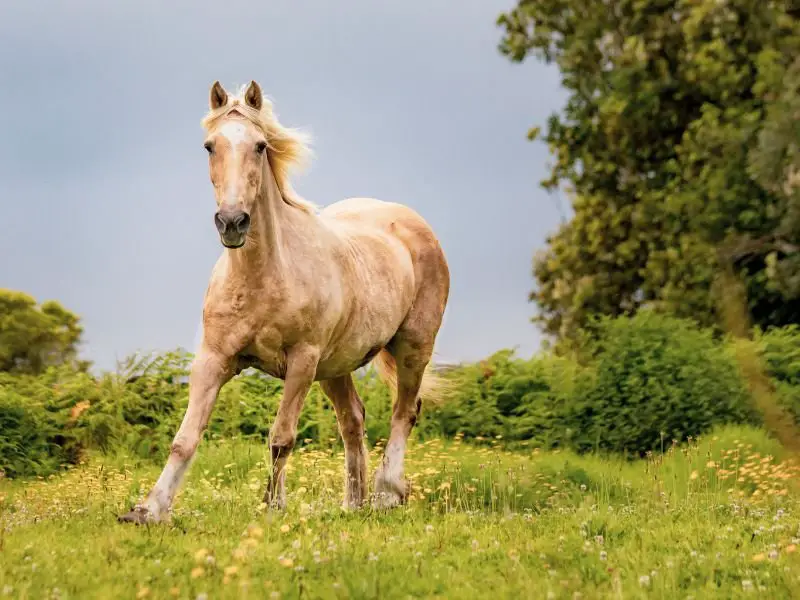
6. Lusitano: The Gold Standard of Equestrian Excellence
The Lusitano horse, hailing from Portugal, is a true marvel in the horse world. Known for their golden coats and versatile abilities, they have become increasingly popular among horse lovers everywhere.
A Historical Background
The Lusitano breed has a rich history that reaches back to ancient times in Portugal. These horses are highly praised not only for their regal looks but also for their intelligence and athleticism.
Coat and Appearance
When you see a Lusitano horse, the first thing you’ll notice is its stunning golden coat. The way the sun hits it, you’ll think it’s glowing. Their well-defined muscles add to their already impressive appearance, making them look both strong and graceful.
Versatility in Disciplines
Lusitanos are not just for show; they excel in a range of equestrian activities. You’ll find them shining in dressage, where they perform complex movements with ease. They are also good at working equitation tasks like herding and overcoming obstacles, demonstrating their diverse skill set.
Temperament: A Partner for All Levels
Lusitanos are known for their exceptional temperament. They’re gentle but spirited, making them good companions for riders ranging from beginners to experts. The special bond that forms between a Lusitano and its rider is one of the reasons they’re gaining popularity outside of Portugal.
Why the Lusitano Captivates
It’s not just about the golden coat or the athletic prowess; it’s the complete package of beauty, skill, and temperament that makes the Lusitano a standout breed. Whether you see one in a high-level dressage competition or out on a trail, you’ll understand why they are considered one of the gold standards in the equine world.
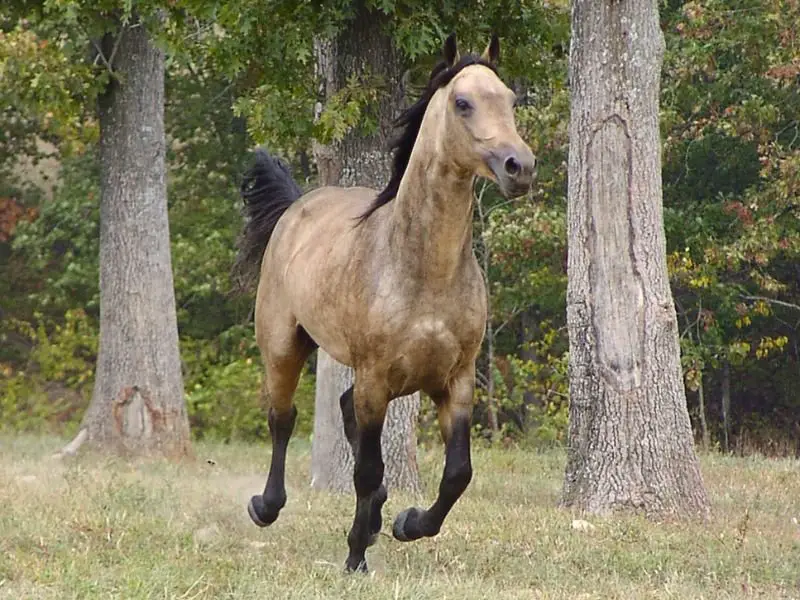
7. Missouri Fox Trotter: Golden Coats and Graceful Gaits
The Missouri Fox Trotter offers a combination of beauty and functionality that’s hard to resist.
Versatility in Riding
Missouri Fox Trotters are more than just pretty faces. They excel in various riding disciplines, from trail riding and pleasure riding to show competitions. Their calm temperament makes them ideal for spending long periods in the saddle.
The Signature “Fox Trot” Gait
What sets Missouri Fox Trotters apart is their unique four-beat gait, known as the “Fox Trot.” This gait offers riders unparalleled comfort and stability, especially over long distances. It’s almost like floating on air while you ride!
A Perfect Partner for Endurance Riding
Because of their unique gait, Missouri Fox Trotters are highly prized for endurance rides and extended trail adventures. Their “Fox Trot” gait allows both horse and rider to cover large distances comfortably.
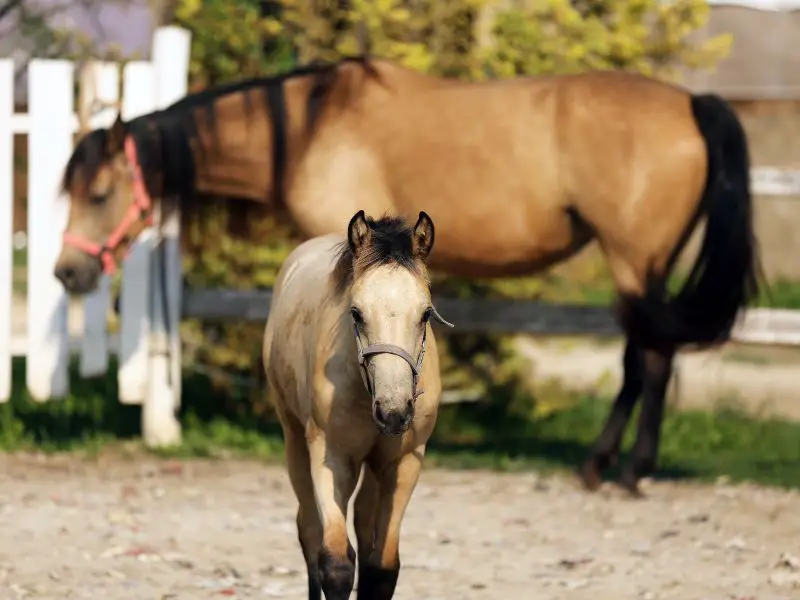
8. Morgan: The Golden Standard of Versatility
Morgan horses are a blend of strength, beauty, and golden hues. Here’s why this breed has earned a place in the hearts of horse lovers.
The Legendary Roots of Golden Morgans
The Morgan horse breed can trace its golden legacy back to a single stallion named Figure. He was a remarkable horse with incredible strength and athleticism, and his descendants have been carefully bred for their standout qualities. Over time, golden-coated Morgans have grown in popularity, enriching the breed’s unique appeal.
Traits That Make Them Stand Out
Morgan horses are more than just beautiful; they’re also loyal and intelligent. They excel in various horse disciplines like driving, dressage, and trail riding. And yes, their golden coats have a knack for catching and reflecting sunlight, making them look like they’re glowing.
Famous Golden Morgans
One such golden Morgan that became famous is Beamington Sensation, also known as “Sonny.” Sonny became a celebrity in the horse world, thanks to his exceptional looks and performance. He’s one among many gold-colored Morgans that have made a lasting impression in horse history.
Why Morgans are Treasured
Morgans are celebrated for more than just their beauty. Their versatility, loyalty, and intelligence make them cherished riding companions across a multitude of disciplines. Moreover, the lineage and history behind these horses add another layer to their allure, making them unforgettable figures in the equine world.
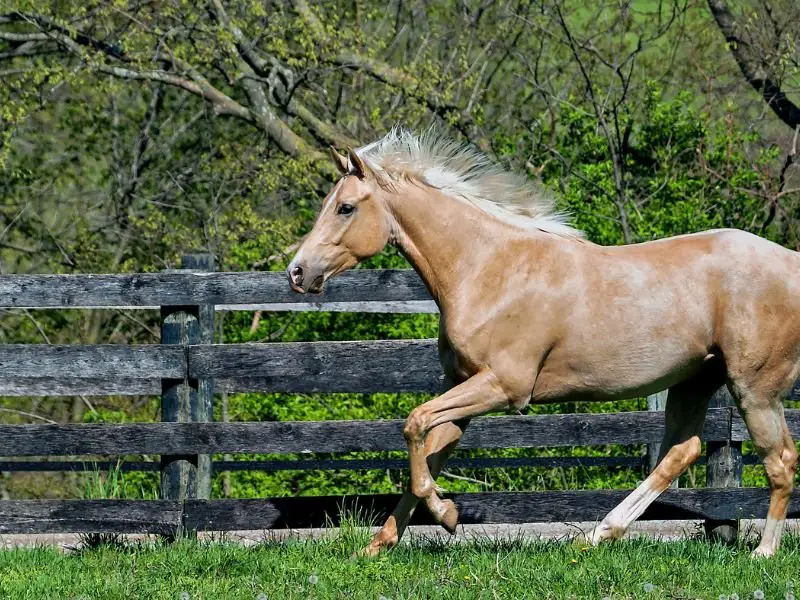
9. Thoroughbred: Where Speed Meets Golden Beauty
Thoroughbreds may be best known for their speed, but some also sport golden coats that make them truly unique.
Gold in the Thoroughbred World
Even though the Thoroughbred standard doesn’t specifically mention a golden coat, you can find individuals with coats that shine like gold. They catch the eyes of both horse enthusiasts and the general public. The range of golden shades can go from deep gold to a lighter, champagne-like color. There is a cremello stallion that produces cremello, palomino and buckskin foals.
Factors Behind the Golden Coats
The golden hue in Thoroughbreds can depend on multiple factors, including genetics and the environment. Each golden Thoroughbred has its own unique look, making them a rare but exciting find in the horse world.
More Than Just a Pretty Coat
Golden Thoroughbreds aren’t just good-looking; they’re also athletes. From racing to jumping and dressage, these horses prove that they can be both beautiful and athletic.
The Lasting Impression
There’s something special about a Thoroughbred with a golden coat. They’re not just racing across tracks; they’re also winning over hearts and minds with their beauty and skills.
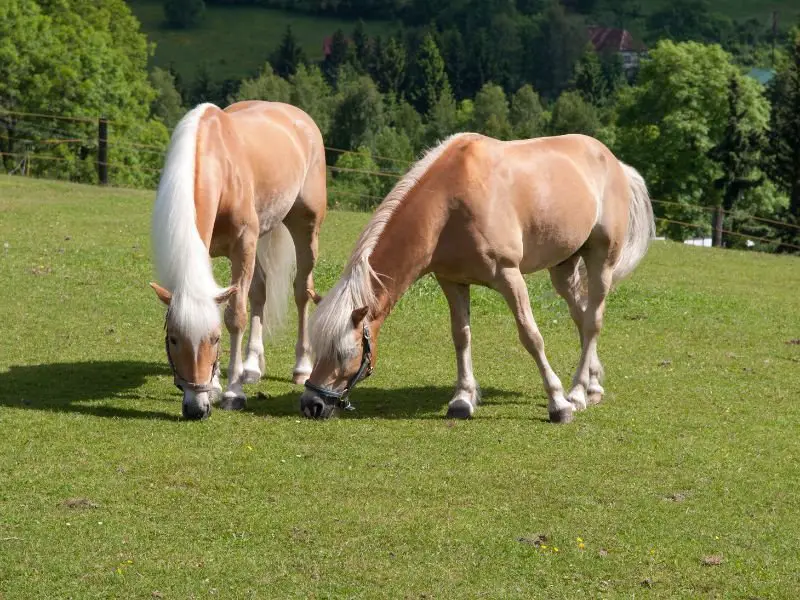
10. Haflingers: The Golden Flaxen Chestnuts
Another beautiful example of flaxen chestnuts in the horse world is the Haflinger breed. These charming horses often look like golden horses because of their flaxen mane and tail combined with a chestnut coat.
A Distinctive Appearance
Haflingers are well-known for their golden chestnut coat and light, almost blonde, mane and tail. This creates an almost golden appearance, making them a standout choice for those drawn to golden-colored horses.
Where Do Haflingers Come From?
Originally from the Tyrolean Mountains between Austria and Italy, Haflingers are a hardy breed suitable for various equestrian activities, from pleasure riding to pulling carriages.
Not Just a Pretty Face
Aside from their eye-catching appearance, Haflingers are also known for their friendly and calm temperament. They’re versatile horses that can adapt to different riding styles and activities, making them excellent choices for both beginners and experienced riders.
If you love the look of a golden horse but are interested in something a little different, a Haflinger could be the perfect fit. They offer the golden allure with the added bonus of versatility and a friendly demeanor.
Conclusion
Horses with golden coats offers a stunning array of beauty and diversity. From the shiny buckskins to the vibrant palominos, these horses never cease to amaze us.
Though golden isn’t officially recognized as its own color in horses, we still see a variety of golden shades across breeds. From the sleek Akhal-Teke to the graceful Tennessee Walking Horse, this golden color appears in many types of horses participating in different activities.
Breeds like the American Quarter Horse, American Paint Horse, Lusitano, and Mustang show off their golden colors too. But it’s not just their appearance that makes them special; each breed also has its unique characteristics and skills that make them valuable members of the equestrian world.
What is your favorite golden coat color? Let us know in the comments!
Cheers, Kacey
P.S. Did you like this article? Gallop over to:

